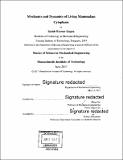Mechanics and dynamics of living mammalian cytoplasm
Author(s)
Gupta, Satish Kumar, Ph.D. Massachusetts Institute of Technology
DownloadFull printable version (5.468Mb)
Other Contributors
Massachusetts Institute of Technology. Department of Mechanical Engineering.
Advisor
Ming Guo.
Terms of use
Metadata
Show full item recordAbstract
Passive microrheology, a method of calculating the frequency dependent complex moduli of a viscoelastic material has been widely accepted for systems at thermal equilibrium. However, cytoplasm of a living cell operates far from equilibrium and thus, the applicability of passive microrheology in living cells is often questioned. Active microrheology methods have been successfully used to measure mechanics of living cells however, they involve complicated experimentation and are highly invasive as they rely on application of an external force. In the first part of this thesis, we propose a high throughput, non-invasive method of extracting the mechanics of the cytoplasm using the fluctuations of tracer particles. Using experimental and theoretical analysis, we demonstrate that the cytoplasm of a living mammalian cell behaves as an equilibrium material at short time scales. This allows us to extract high frequency mechanics of the cytoplasm using the generalized Stokes-Einstein relationship. The results obtained are in excellent agreement with our independent optical tweezer measurements in this equilibrium regime. Studies often assume cytoplasm as an isotropic material. However, under various physiological processes such as migration, blood flow on endothelial cells, it can undergo morphological changes which can induce significant redistribution of the cytoskeleton. Evidence of induced anisotropy for cells under mechanical stimuli exists however, the role of cytoskeletal restructuring on mechanical anisotropy remains unclear. Moreover, the effect of this restructuring on intracellular dynamics and forces remains elusive. In the second part of this thesis, we confine the cells in different aspect ratio and measure the mechanics of the cytoplasm using optical tweezers in both longitudinal and transverse directions to quantify the degree of mechanical anisotropy. These active microrheology measurements are later combined with independent intracellular motion measurements to calculate the intracellular force spectrum using Force Spectrum Microscopy (FSM); from which the degree of anisotropy in dynamics and forces are quantified.
Description
Thesis: S.M., Massachusetts Institute of Technology, Department of Mechanical Engineering, 2017. Cataloged from PDF version of thesis. Includes bibliographical references (pages 53-58).
Date issued
2017Department
Massachusetts Institute of Technology. Department of Mechanical EngineeringPublisher
Massachusetts Institute of Technology
Keywords
Mechanical Engineering.